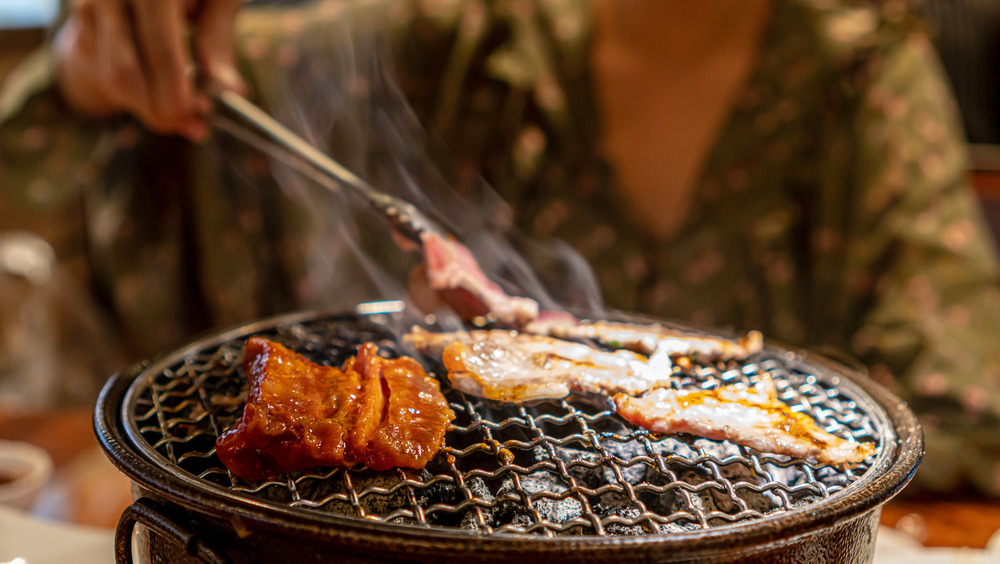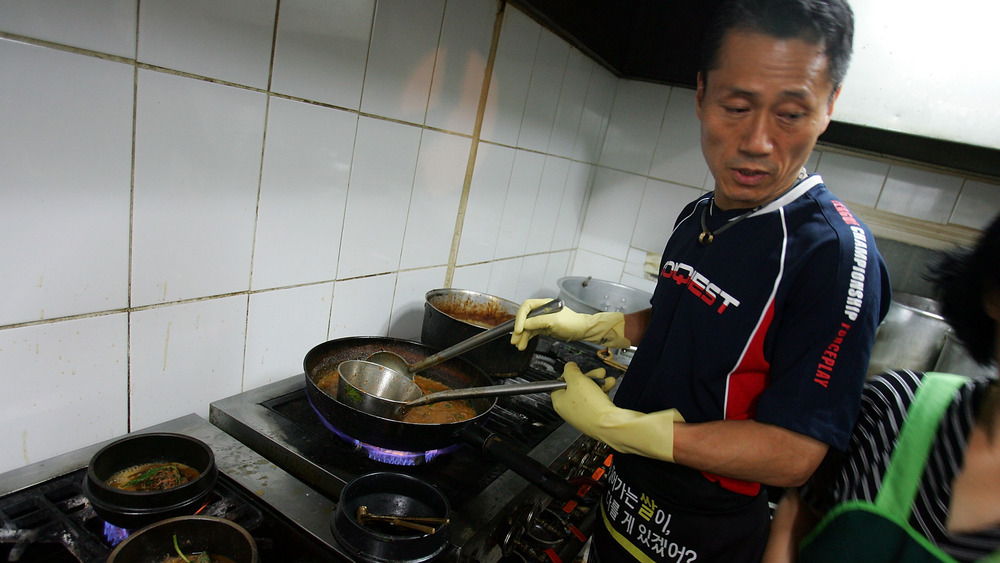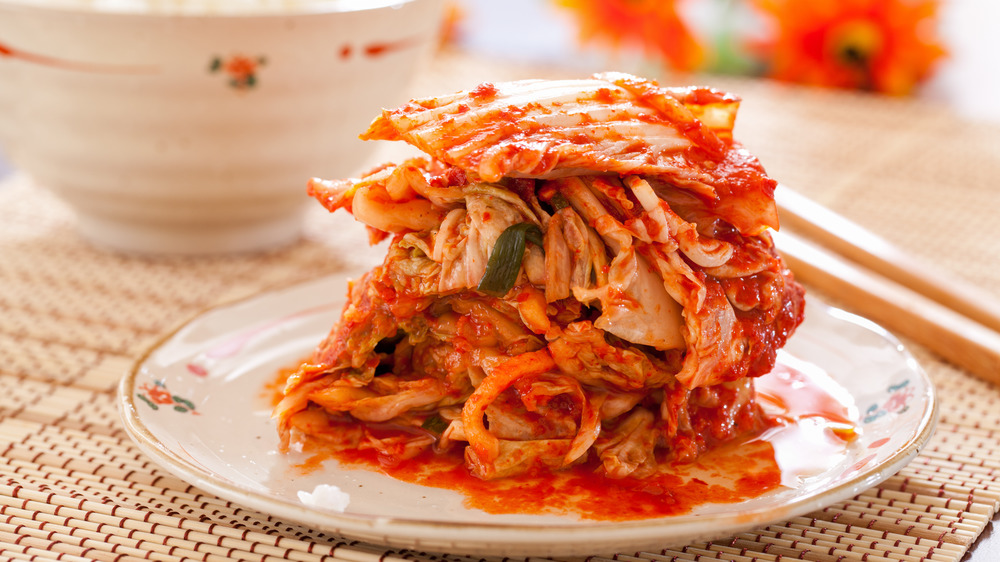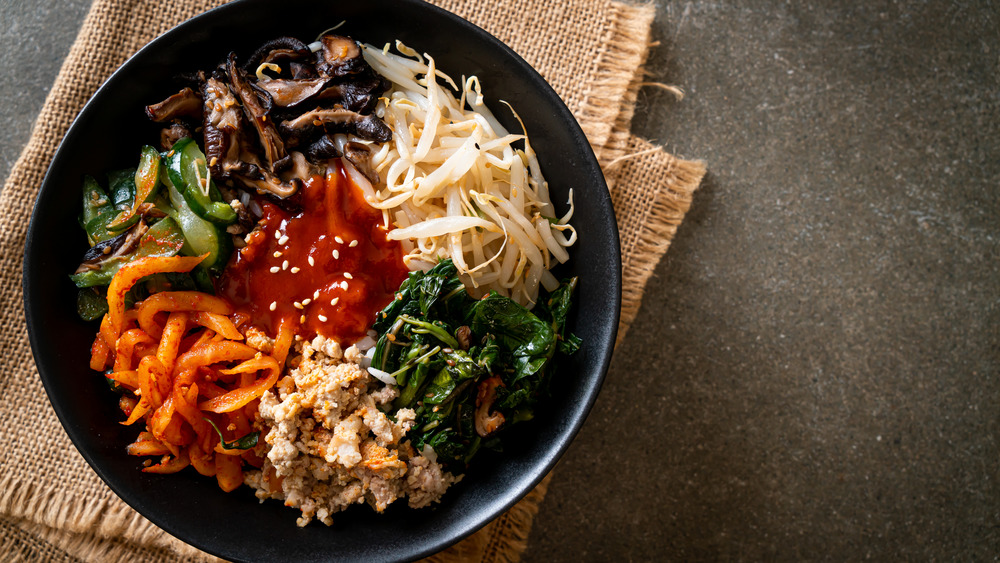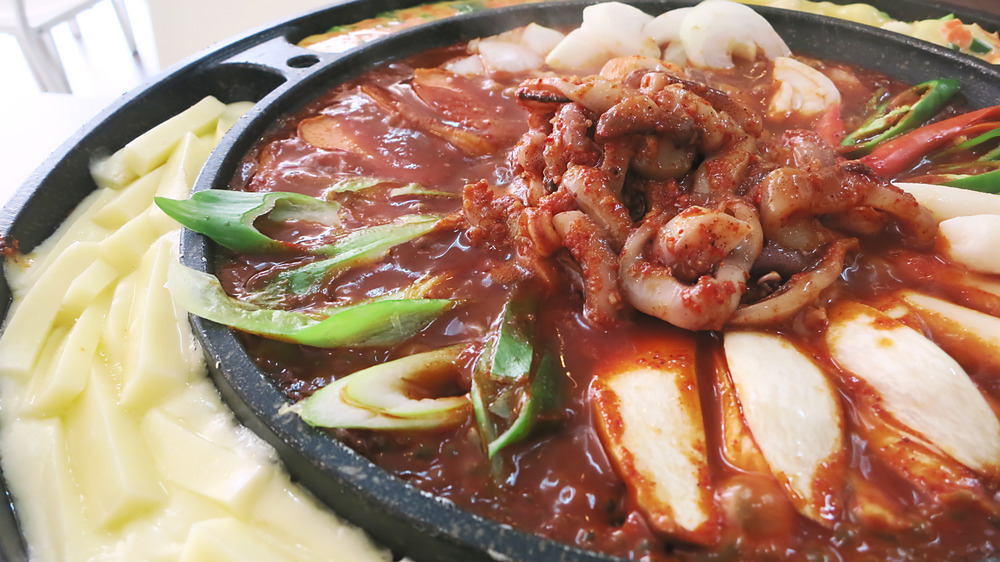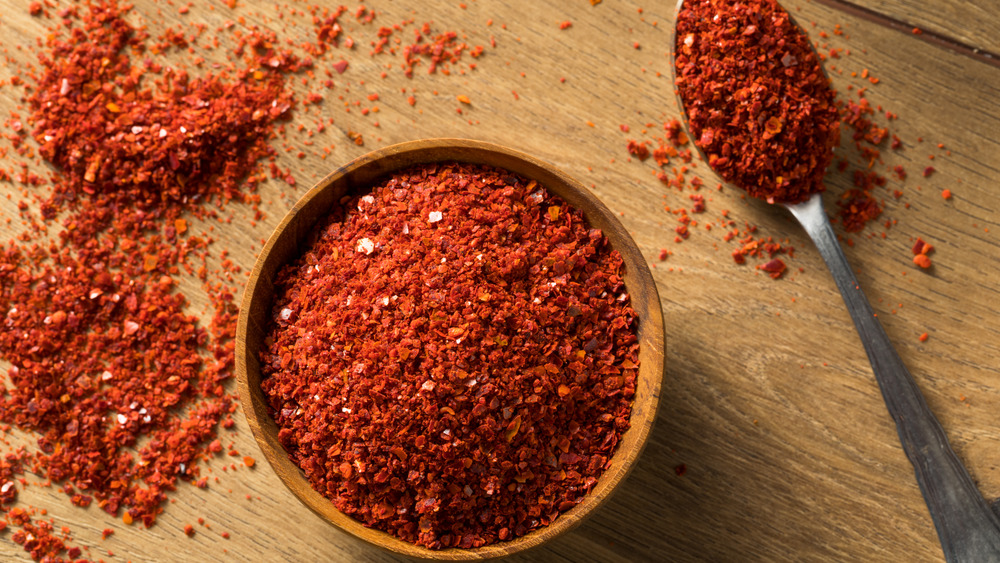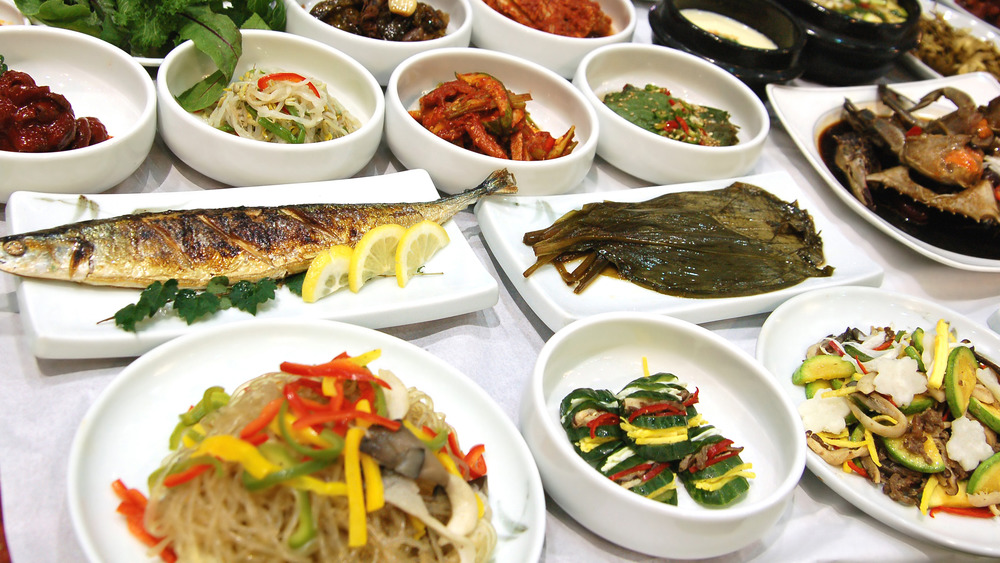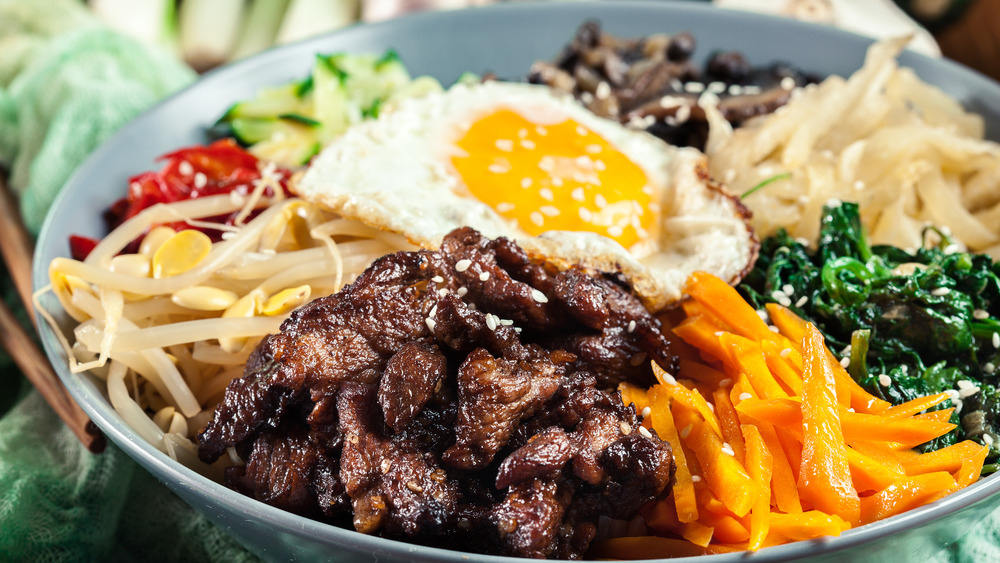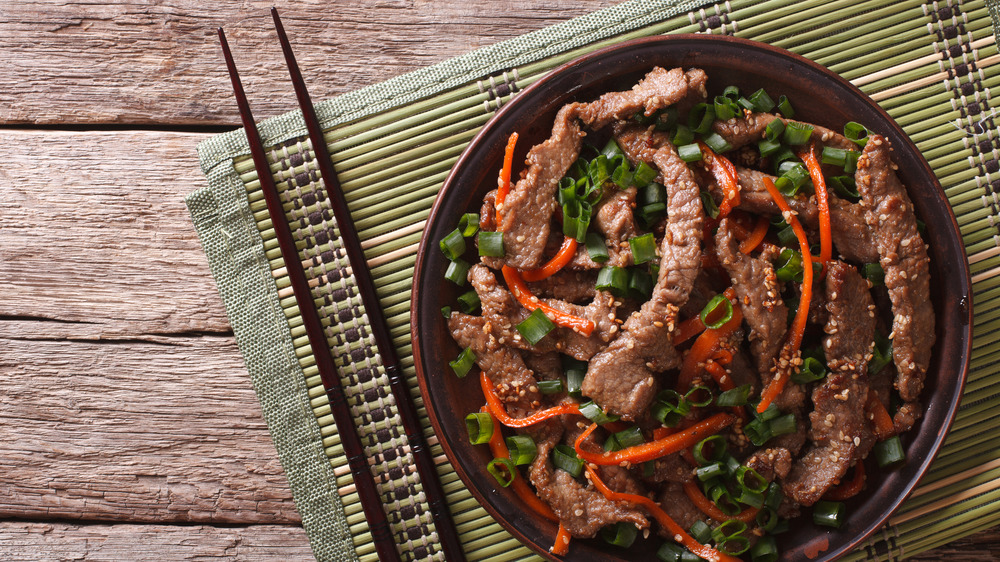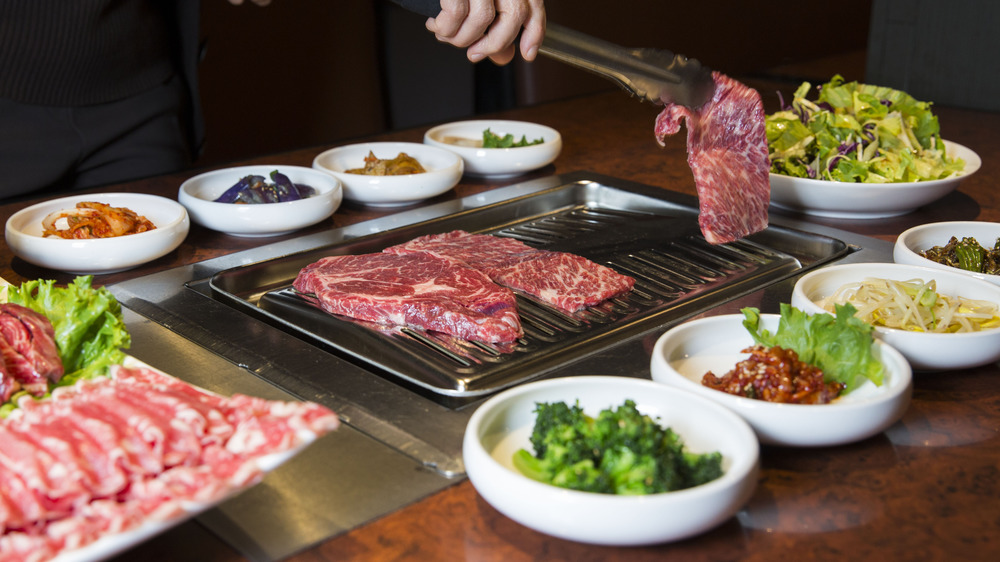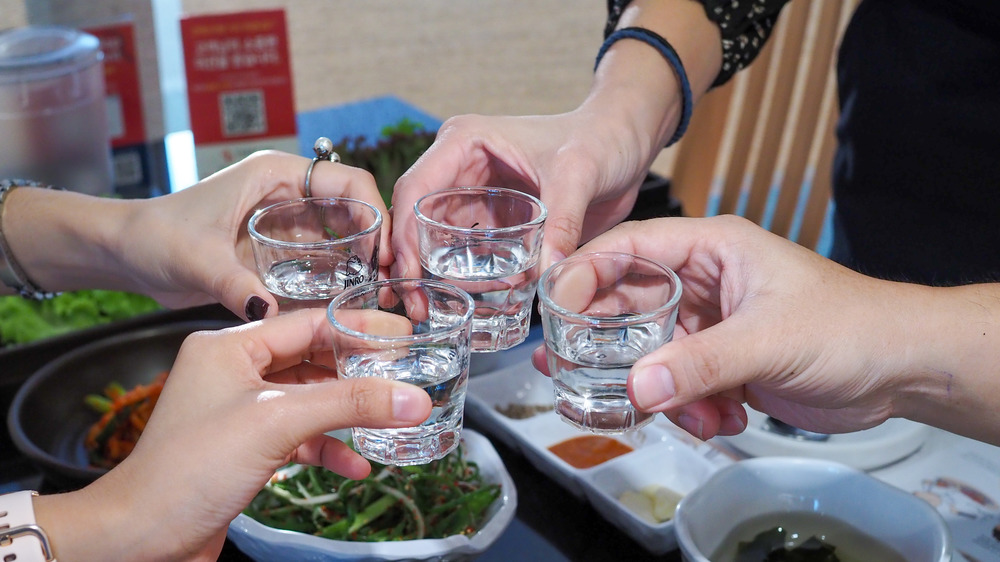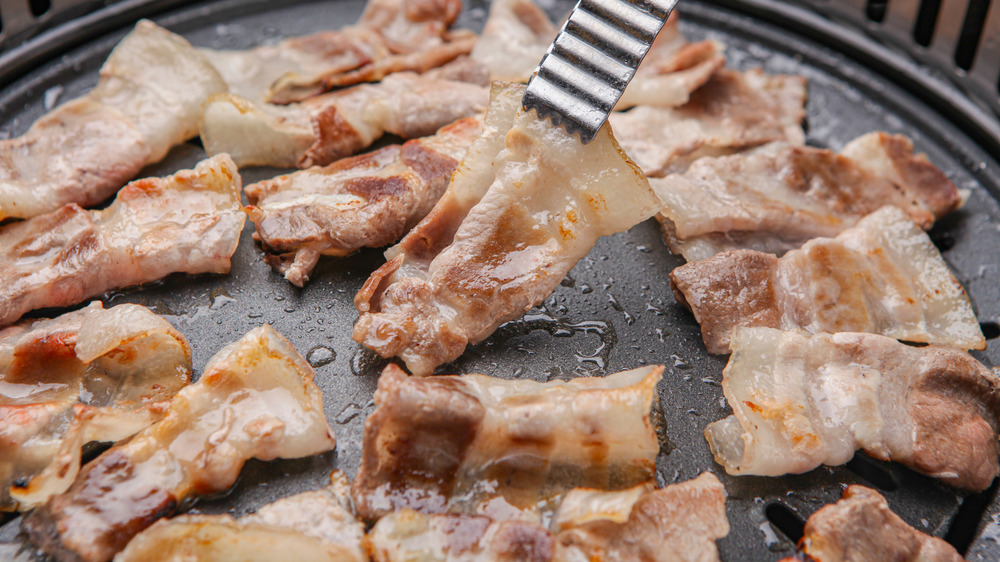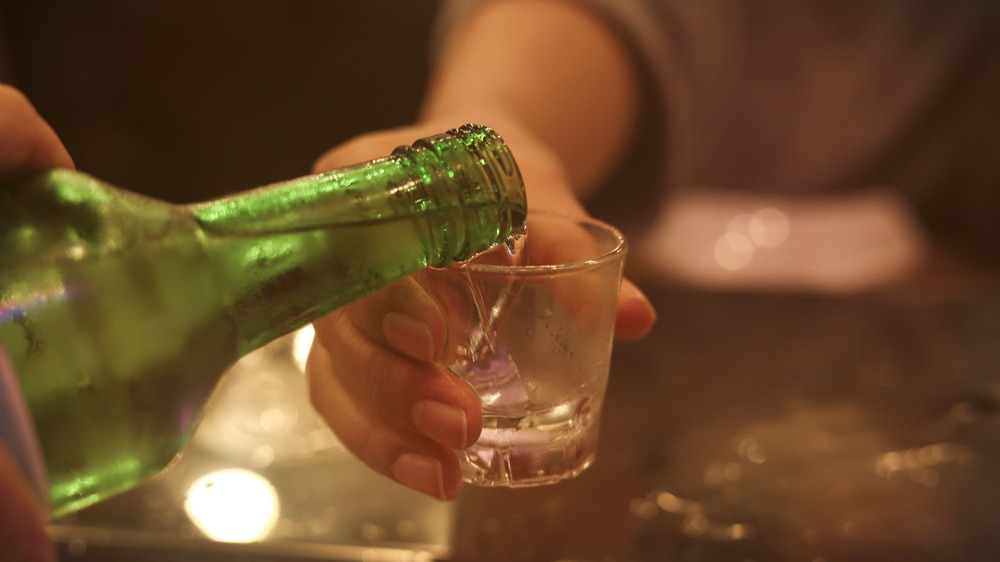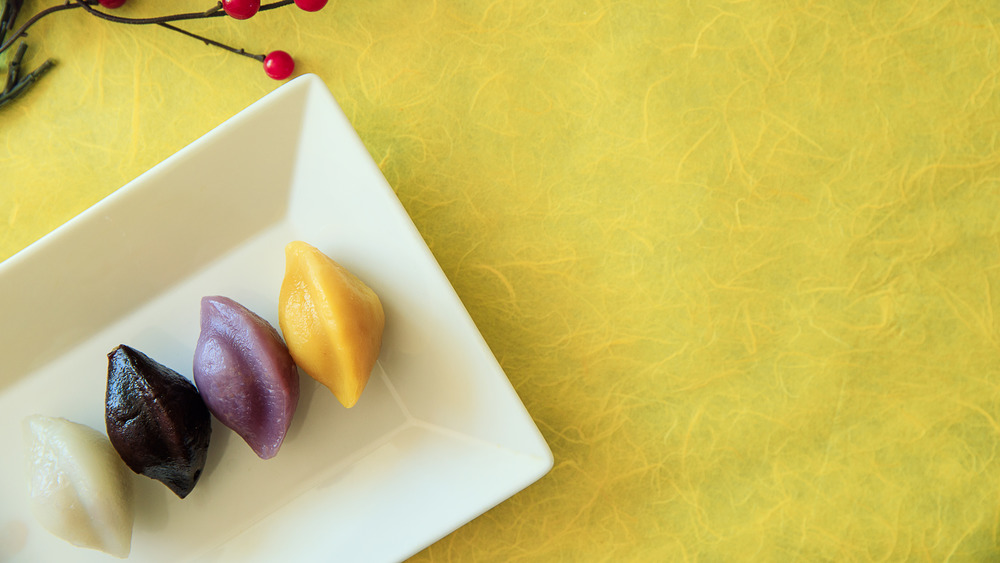Things You Should Never Do In A Korean Restaurant
Korean food has exploded in popularity over the past decade or so. Now, this cuisine is filling many of our cities with the smell of its smoky, spicy deliciousness, from high-end barbecue restaurants to fast-casual food stalls. You might even find it fused with other cuisines, like at Korean taco trucks, and as the centerpiece of large, celebratory meals, where cooking your own meat is the center of the action. While some of us may question how, exactly, it became cool to pay a premium to save the restaurant kitchen some work, there's no denying the fun to be had when you're sipping soju and flipping meat amongst friends.
But Korean food isn't limited to barbecue restaurants and food trucks. Some of the best examples of Korean cuisine can be found in little mom-and-pop spots nationwide. Though they're all welcoming, you would be well served to make sure you know what you're doing before you walk in. From not shooting all your soju at once, to never asking a chef to modify a dish, there are a few things you shouldn't do at a Korean restaurant. We talked to Jennifer and Michele Kaminski, two sisters who own the massively popular 2 Korean Girls kitchen in Miami. They clued us into some moves you should avoid when you next find yourself dining in a Korean restaurant.
Don't try to modify your dish at a Korean restaurant
As Americans, we're quite used to strolling into a restaurant and ordering a bacon cheeseburger, minus the bacon or cheese. But Korean restaurants aren't so flexible about changing their ingredients. This isn't so much a way to make things difficult for guests, but rather indicative of the pride Koreans take in their food and culture.
"There are so many layers and flavors to Korean cuisine. Leave it in the hands of the experts," says Jennifer Kaminski. According to Jennifer, if you ask for modifications, there's a good chance you'll be met with, at best, a vicious side-eye. "Or," she adds, "They may give you a no-nonsense reply of 'that's not how you make it. That's not how you eat it. Go eat someplace else.'"
Her sister Michele adds that this is not because the proprietors of the restaurant don't want to be hospitable. It's just that they're proud of their culture and want to share it in its unadulterated form. Since they know how the flavors are supposed to blend, they want the guest to get the best experience possible.
Don't expect kimchi to taste sour at a Korean restaurant
The kimchi most of us in America are used to is a sort of pickled vegetable mix. That version can be an acquired taste, especially if you're not into sour foods. But it's actually only one kind of kimchi that's out there, so don't immediately expect a big plate of sour stuff when you see it on the menu. Similar to curries in other countries, kimchis in Korea vary greatly from region to region, says Michele Kaminski. And, similar to wine, much of the flavor depends on how long the kimchi has been fermenting.
Since the Kaminski's mother typically served them fresher, less fermented kimchi while they were growing up, the sisters got a rude awakening the first time they tried the kimchi more familiar to Americans. "The first time I ever had sour kimchi, I made this face, and my mom was like, 'what's wrong?'" she says. "I told her it went bad, and she tried it, and said, 'Oh no, this is how we're meant to enjoy it." Conversely, she adds, many people try fresh kimchi and tell her something along the lines of, "This isn't kimchi.'" The truth is, they're both right.
Don't send cold food back at a Korean restaurant
Like many other restaurants, 2 Korean Girls is a "ghost kitchen". According to The Washington Post, ghost kitchens come without dining rooms, meaning that they're set up to focus on delivery and take-out orders, potentially making them the future of dining because of the COVID-19 pandemic. Operating as a ghost kitchen means that nearly all the food consumed from 2 Korean Girls has to go on a car ride before it hits the table. More than one diner has complained the food was cold by the time they got it. That isn't necessarily the fault of the restaurant or the delivery driver, but rather the expectations of the eater. As it turns out, not all Korean food is supposed to be served warm.
Food like bibimbap and banchan are typically supposed to be served cold, as this is the traditional preparation of most vegetable dishes in Korean cuisine. "They're more picnic-style when they get served," says Michele Kaminski. "They're prepared salad style and they're meant to be enjoyed cold. Really, they should be chilled." So before you leave a bad review complaining that a Korean restaurant should speed things up or use different delivery containers to keep food nice and hot, take a second to consider the cuisine. Sometimes, you are really are supposed to get cold food.
Sometimes you shouldn't order cheese at a Korean restaurant
In many modern Korean restaurants, it's not at all uncommon to be offered a side of cheese to enjoy with your grilled meat. Jennifer Kaminski tells the story of going to a restaurant in Los Angeles' Koreatown and ordering five different types of meat, and the server asking her if she wanted a side of cheese with it. Having grown up going to mostly old school Korean restaurants in Chicago, it seemed an odd request, but she ordered it anyway. The server brought a cup of shredded cheese, which guests were able to melt and use as a dip for their meat, almost like a Korean barbecue fondue fusion.
"So most modern barbecue places now, they ask you if you want cheese," Jennifer says. The keyword there is modern, though, so diners looking for a little provolone with their pork belly should understand that more traditional places may not honor this request. "If you go into an old school joint, they might ask you to leave," she adds. She's joking, of course, but perhaps don't try to push your luck when it comes to cheese and more traditional Korean barbecue places.
Don't order spicy stuff at a Korean restaurant and think it'll knock your socks off
Lumping all cuisines together is maybe the biggest mistake one can make when exploring different foods from the vast and diverse Asian continent. Just because Korean food uses chili peppers, often called gochu, in a lot of dishes, don't expect a spice explosion of the sort that you might in Thai or Indian food. "Korean spice is different from other Asian cuisines," says Jennifer. Her restaurant offers a dish called "Oh you spicy, huh?" that pushes back against those assumptions. It's a bowl with spicy chicken, two types of kimchi, and gochujang sauce that packs a moderate-yet-flavorful punch. As Jennifer explains, "Korean spice has more flavor and is more rounded, compared to Thai spice or Indian spice. It has a spice level to it, but it's not on a scale of one to five."
She says they use an ingredient called "fire oil", but unlike what you might expect from an ingredient that sounds like a towering inferno, it just adds an extra kick. "I have a pretty high tolerance for spice," adds Michele Kaminski, co-owner of 2 Korean Girls. "What I've learned with Korean food is [to cook] for friends with mild taste buds, [but] it's still manageable."
Don't ask for more banchan in a Korean restaurant, unless you're with a regular
Banchan, if you're not familiar, is a collection of traditional Korean side dishes that include kimchi, pickled vegetables, soup, and a few egg dishes, according to Tripzilla. But they are meant as little noshes to enjoy before the main course gets to the table. They are definitely not the main meal. Unlike the unlimited bread served by many restaurants or the chips and salsa at your favorite place that inevitably fill you up before your tacos get there, banchan is not meant to be endlessly devoured.
"You might get met with a side-eye if you ask for more banchan," Michele warns. Although, she adds, if you go in with a regular or someone who speaks Korean, that request will be a little better received. This may be because you won't look like a glutton trying to score a full meal of free vegetables. It could also be because of your connections, assuming the person you're taking out to dinner has the right kind of connections with the restaurant to score a few extra dishes of banchan with no hard feelings.
Don't deconstruct your bibimbap at a Korean restaurant
There are people who obsessively separate the food on their plates and refuse to eat anything that's touched a different bite of food. Then, there are people who pile their plate with everything like they're at a buffet, then mix it all together like a delicious or, depending on your mood, horrifying casserole. For that second group, bibimbap bowls are perfect. That first group of picky eaters, however, might want to opt for something other than these bowls, though they're popular at many Korean restaurants.
"Bibimbap is meant to dump sauce into a bowl, get your big spoon, dig into the egg, and mix the whole thing up," says Michele Kaminski. "It's not meant to be picked apart or deconstructed, it's meant to be mixed up into one big, happy family."
She tells a story of her friends trying the bibimbap bowls when 2 Korean Girls first opened. They sent the sisters pictures of their bowls fully deconstructed. The horror they felt was something like watching your well-meaning kid draw a mustache on the Pablo Picasso print you recently hung in the living room. "We were like, 'What are you doing?'" she says, though she didn't reveal if any of her friends bothered to reconstruct their bibimbap bowls.
Don't ask for a fork at a Korean restaurant
"Eating with your hands is 100 percent acceptable to do," says Michele Kaminski. Things like lettuce wraps are meant to be eaten with your hands. She also says gim, which is Korean seaweed rolled with rice and a variety of different proteins, should also be eaten without utensils. When it comes to other foods, she advises always using chopsticks if you can. "You might get a look if you ask for a fork," she says
Interestingly, Korean chopsticks may be a little different than the ones you've perhaps fumbled over as you tried to eat sushi rolls or lo mein. Typically, Korean chopsticks are made from stainless steel, not wood. Unfortunately, if you've encountered trouble gripping wooden chopsticks, the metal kind will present an especially slippery challenge. Not to worry, though, as there's nothing to be ashamed of in asking for a set of wooden chopsticks, according to Thrillist. Not every restaurant will have them, however, so you may want to practice your chopstick skills at home if you're especially worried about handling your food. Don't worry too much, though, as chopsticks are actually pretty easy to learn how to use.
Don't immediately cut your meat when eating Korean barbecue
Cutting or grilling your own meat, according to the Kaminski sisters, is another one of those instances that's a bit like ordering cheese at a Korean restaurant. In other words, different restaurants have different customs. Some places will let you do this, but other places like to cut and cook your meat for you. In fact, the latter is more common. The best bet is to wait and see what your restaurant staff wants to do.
"Sometimes a waitress comes by with scissors and cuts your meat, and they usually won't ask," says Michele Kaminski. "That's a good sign. They'll usually do what's right for you."
In addition, Tripzilla recommends waiting a few minutes once the grill is hot to begin grilling your meat if you're in a grill-it-yourself kind of place. The site suggests rubbing an onion over the grill to spread the cooking oil around to ensure the meat doesn't stick. Then, only flip it once onto each side for about two to three minutes each, to make sure the meat is cooked just right.
Don't take shots of soju at a Korean restaurant
Soju, if you're not up on your Asian distilled spirits, is a clear liquor that's also the national drink of Korea, according to Vinepair. It was traditionally made with rice until World War 2, when rice distillation was banned. After that, soju was often made with wheat and other starches. That ban was lifted in the 1990s, but the base grain still varies wildly across brands. As a result, so does the flavor of many modern soju liquors.
"In America, soju has been seen as a distilled spirit that doesn't follow the rules of a distilled spirit," Ryan Te, the beverage director at Oiji in New York City, told Vinepair. "It's almost watered down, and it can be served with the same license as a beer and wine license."
That means it's far easier for a restaurant to obtain a license to sell soju, which makes it pretty ubiquitous in Korean restaurants nationwide. That said, just because it won't punch you in the face like tequila can doesn't mean you should shoot the whole thing. Yes, it's served in shot glasses. And yes, it's smooth. But it should never be shot repeatedly, lest you let the smooth taste of this drink, which the Los Angeles Times says is often around 24 percent alcohol by volume, lull you into a false sense of security.
Don't forget to change your grill between meats at Korean restaurants
Sure, when you're barbecuing burgers and corn on the regular at home, you might hit it with the grill brush between uses and then do a deep cleaning at the end of the season. But the grill at a Korean barbecue restaurant doesn't work like that. You're gonna need to give it a little more maintenance, even during a single dinner. Since you're cooking all kinds of stuff on the grill, bits of food will inevitably get left behind. Unless you enjoy tasting beef with a hint of shrimp and pork belly, Thrillist recommends switching out your grill regularly.
Of course, it's not like there's a big stack of grills sitting there next to your table. So how does one go about replacing it? Tripzilla says that, typically, servers will come by and do this for you every time they notice the setup is getting a little sticky. But sometimes a restaurant is busy and they won't have time to pay attention to the relative cleanliness of your grill. In this case, much like with water refills, the site suggests asking your server to swap you out a new one. This is a pretty common request, so don't hesitate to ask.
Don't pour your own drink at a Korean restaurant
Anyone who's ever spent a night out in Tokyo with a bunch of new business acquaintances and who has had way more sake than they'd intended knows you should never pour your own drink in Japanese culture. Well, the same goes for Korean culture, where pouring for yourself is a big no-no and goes strongly against the collectivist spirit of eating.
Michele Kaminski, co-owner of Miami's 2 Korean Girls restaurant, says that, in a group setting, you should always be pouring each other's drinks. You should definitely never, ever pour your own. "When you drink, it's meant to be enjoyed in company," she says. "We all know a solo drink by yourself is great too, that is a thing, but when I'm ordering a drink they're always pouring it for me, and encouraging, 'No, no! You guys pour for each other.'" Peer pressure? Perhaps. But we'll just chalk it up to being polite and enjoying a night out with friends.
Don't expect to order dessert in a Korean restaurant
At first, it may seem counterintuitive for a restaurant to discourage ordering dessert since an extra course means an extra source of income. The fact is, many Korean restaurants do offer dessert and are happy to serve it to you. The Kaminskis' restaurant 2 Korean Girls, for example, offers stuff like Korean pear with chocolate sauce and red bean chia pudding alongside an impressive selection of after-dinner teas. While they are all delicious, don't expect to find this on the menu in every Korean restaurant you visit, and especially not in Korean barbecue joints.
Tripzilla says that, in Korea, barbecue restaurants don't serve dessert, period. Asking for it will make you seem out of place, though some spots may offer fruit, watermelon, or something similar. Thrillist concurs, similarly advising against ordering dessert since most restaurants simply won't have it. Anyway, if you've eaten properly, you won't have room for dessert.
